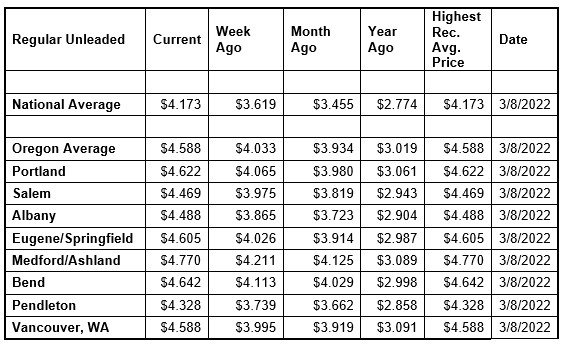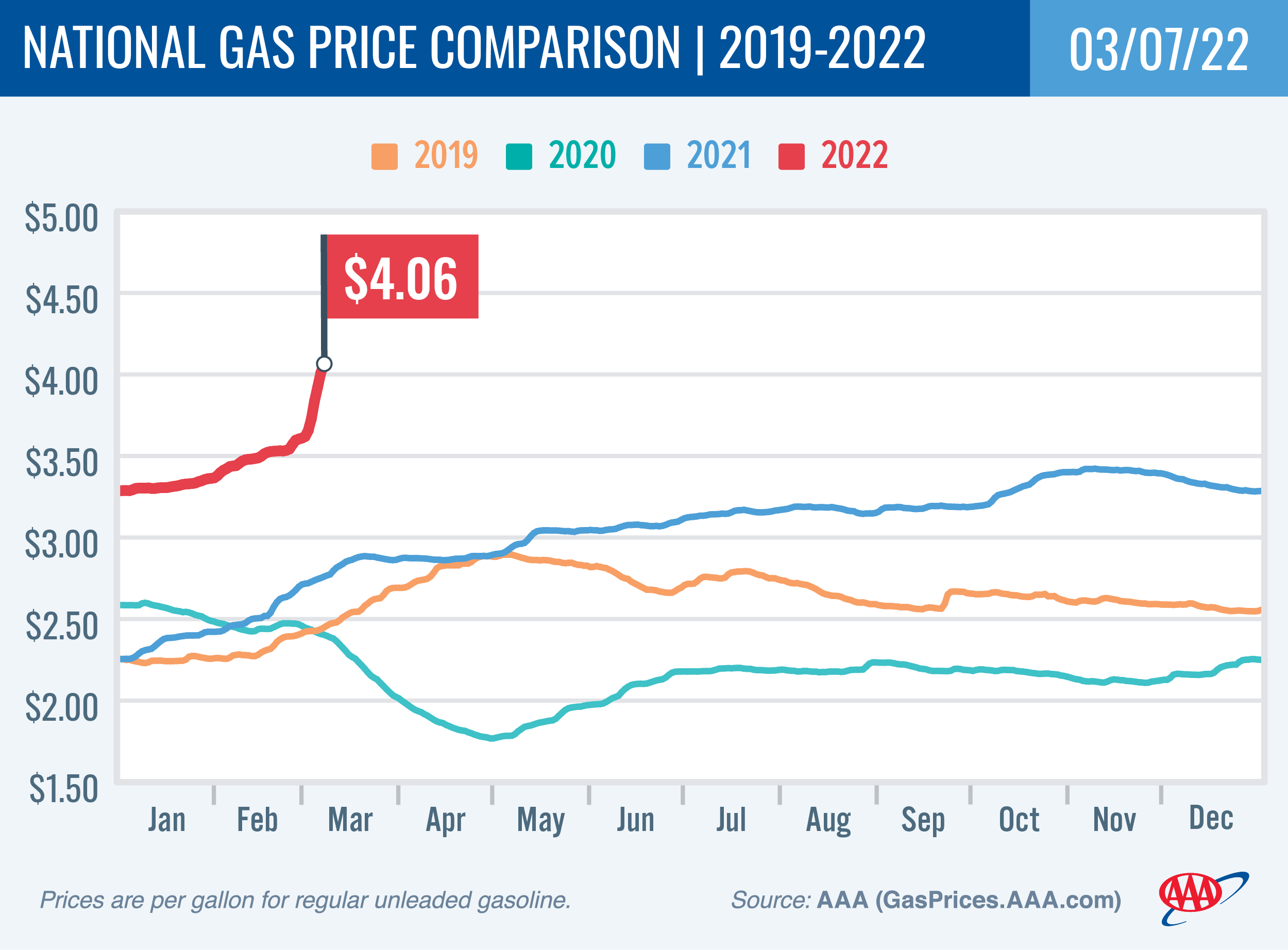High Desert gas prices follow rest of U.S. to record territory amid Ukraine upheaval, AAA says

Bend's price tops $4.64 a gallon - only Medford is higher
PORTLAND, Ore. (KTVZ) – Russia’s unprovoked and violent invasion of Ukraine has sent crude oil prices skyrocketing above $120 a barrel, the highest price since July 2008. The soaring oil prices have sent gas prices to new record highs, breaking records set in 2008, AAA Oregon-Idaho said in Tuesday's weekly update.
All 50 states are seeing dramatic increases in gas prices. For the week, the national average for regular jumps 54 cents to $4.17 a gallon. The Oregon average shoots up 55 cents to $4.59.

These prices eclipse the old record highs set in 2008 when the national average peaked at $4.11 on July 17, and the Oregon average peaked at $4.29 on July 3.
Today, President Biden announced a U.S. ban on Russian oil imports. The President said this has strong bipartisan support in Congress as Americans rally to support the Ukrainian people, and that this and other sanctions have wreaked havoc on the Russian economy. But President Biden says there will be costs as well here in the U.S., including even higher gas prices which hurt American families.
The United Kingdom also announced it will phase out Russian oil imports by the end of the year. The European Union has also outlined a plan to stop using Russian energy.
About 8% of oil used in the U.S. last year came from Russia, while about 25% of Europe’s oil is imported from Russia. The U.S. is the largest oil producer in the world. Other top producers are Saudi Arabia and Russia.
Last week, the International Energy Agency (IEA) announced a coordinated release of crude oil from its 31 member countries’ strategic reserves, including the U.S., Germany, Canada, South Korea, and Mexico, to help counter the impact of rising crude prices. On Friday, IEA said member states committed to releasing a total of 61.7 million bbl from their strategic reserves to reassure markets roiled by the fallout from Russia’s invasion of Ukraine. This amount—half of which is expected to come from the U.S.—is the largest coordinated release since IEA was founded in 1974.
“Drivers are experiencing pain at the pumps, and its impossible to predict how high prices might go, as a war rages in Europe. Besides the tragic human toll, the Russian invasion of Ukraine is having economic consequences here at home and around the world,” says Marie Dodds, public affairs director for AAA Oregon/Idaho.
Traditionally, gas prices jump in March and April, as the switch to summer-blend fuels occurs and the spring and summer travel season heat up.
U.S. gasoline demand rose slightly from 8.66 million b/d to 8.74 million b/d. Total domestic gasoline stocks decreased by 500,000 bbl to 246 million bbl last week, according to the U.S. Energy Information Administration (EIA). The increase in gas demand and a reduction in total supply contribute to rising pump prices. But the major driver is rising oil prices. Consumers can expect gas prices to keep climbing as long as crude prices rise.
Quick stats
All 50 states and the District of Columbia have significant increases for the week. Virginia (+66 cents) has the largest weekly increase. Hawaii (+15 cents) has the smallest. Oregon (+55 cents) has the 27th-largest increase in the nation.
California ($5.44) is the most expensive state in the nation and is the first state to ever have an average above $5 a gallon. There are 28 states and the District of Columbia with an average at or above $4 a gallon.
The cheapest gas in the nation is in Oklahoma ($3.72) and Missouri ($3.73). This week no states have averages below $3 a gallon, same as a week ago. For the 61st week in a row, no state has an average below $2 a gallon.
All 50 states and the District of Columbia have higher prices now than a month ago. The national average is 72 cents more and the Oregon average is 65 cents more than a month ago. This is the 33rd– largest monthly increase in the nation. Delaware (+83 cents) has the largest month-over-month increase. Hawaii (+30 cents) has the smallest.
All 50 states and the District of Columbia have higher prices now than a year ago, and all have a current average that’s a dollar or more higher than a year ago. The national average is $1.40 more and the Oregon average is $1.57 more than a year ago. This is the third-largest yearly increase in the nation. California (+$1.69) has the biggest yearly increase. Nebraska (+$1.04 cents) has the smallest year-over-year increase.
West Coast
The West Coast region continues to have the most expensive pump prices in the nation with every state except Arizona in the top 10.
| Rank | Region | Price on 3/8/22 | ||
| 1 | California | $5.44 | ||
| 2 | Hawaii | $4.72 | ||
| 3 | Nevada | $4.67 | ||
| 4 | Oregon | $4.59 | ||
| 5 | Washington | $4.55 | ||
| 6 | Alaska | $4.50 | ||
| 7 | Illinois | $4.43 | ||
| 8 | New York | $4.37 | ||
| 9 | Connecticut | $4.36 | ||
| 10 | District of Columbia | $4.35 |
California is the most expensive state for the 59th week in a row with Hawaii, Nevada, Oregon, Washington, and Alaska rounding out the top six. Arizona is 12th. Oregon is fourth for the second week in a row.
Like the rest of the country, all seven states have weekly increases: Nevada (+64 cents) has the largest in the region while Hawaii (+15 cents) has the smallest week-over-week increase in the region and the nation.
The refinery utilization rate on the West Coast is relatively steady, going from79.9% to 79.5% for the week ending February 25. The rate has ranged between about 76% and 88% in the last year.
According to EIA’s latest weekly report, total gas stocks in the region rose slightly from 29.88 million bbl. to 29.99 million bbl.
Oil market dynamics
Crude prices continue to surge in response to the invasion of Ukraine by Russia. As the conflict continues, the oil markets will likely respond this week by increasing the price of crude oil to reflect more risk of disruption to tight global oil supplies. Additionally, EIA reported that total domestic crude stocks decreased by 2.6 million bbl last week to 413.4 million bbl. The current stock level is approximately 15% lower than at the end of February 2021, contributing to pressure on domestic crude prices.
At the close of Friday’s formal trading session, WTI increased by $8.01 to settle at $115.68. At Monday’s formal trading session, WTI rose $3.72 to close at $119.40. Today crude is trading around $127, compared to $103 a week ago. Crude prices are about $61 more than a year ago.
Drivers can find current gas prices along their route with the free AAA Mobile app for iPhone, iPad and Android. The app can also be used to map a route, find discounts, book a hotel and access AAA roadside assistance. Learn more at AAA.com/mobile.

Diesel
For the week, the national average soars 74 cents to $4.76 a gallon. Oregon’s average jumps 55 cents to $4.59. A year ago the national average for diesel was $3.01 and the Oregon average was $3.05.
Find current fuel prices at GasPrices.AAA.com.
Find lowest prices on the High Desert at KTVZ.COM's Pump Patrol page, fueled by GasBuddy.